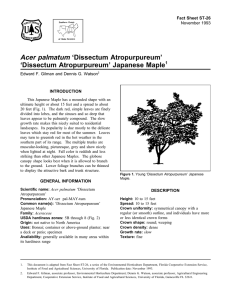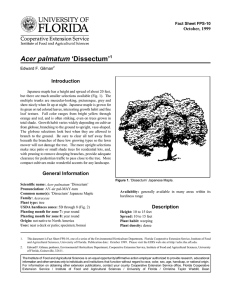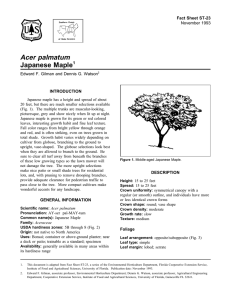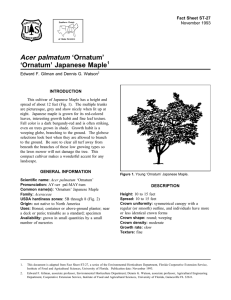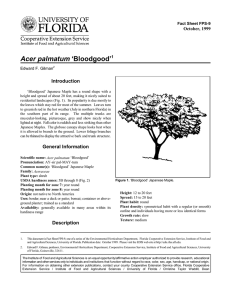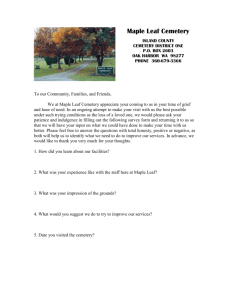Acer palmatum ‘Atropurpureum’ ‘Atropurpureum’ Japanese Maple Fact Sheet ST-24 1
advertisement
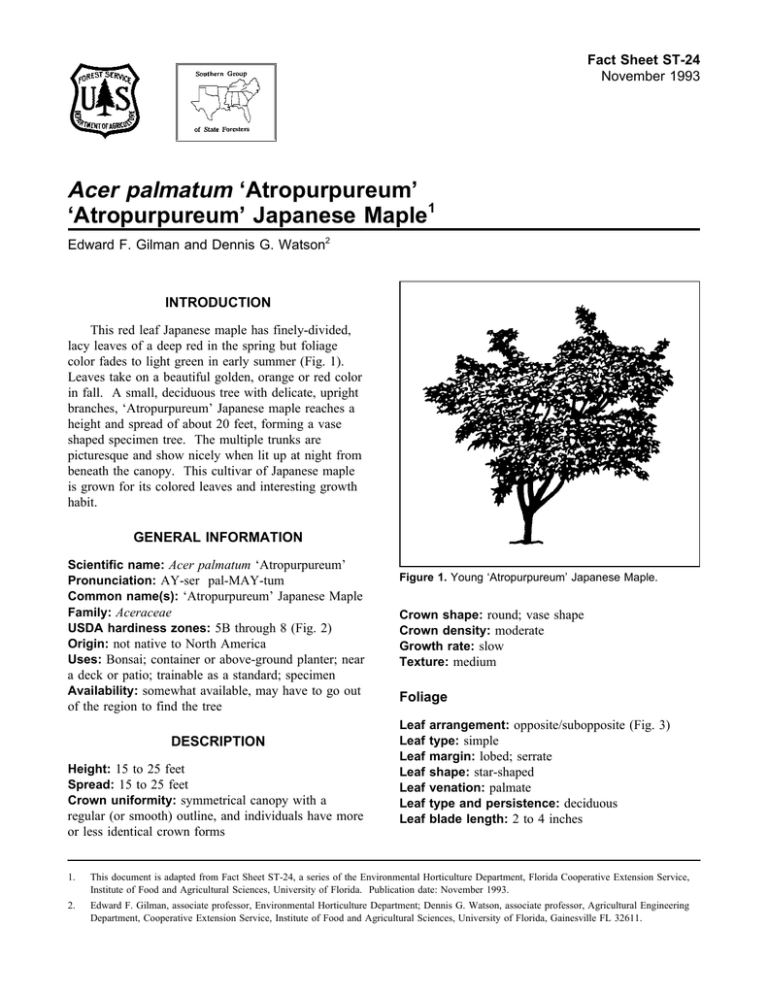
Fact Sheet ST-24 November 1993 Acer palmatum ‘Atropurpureum’ ‘Atropurpureum’ Japanese Maple1 Edward F. Gilman and Dennis G. Watson2 INTRODUCTION This red leaf Japanese maple has finely-divided, lacy leaves of a deep red in the spring but foliage color fades to light green in early summer (Fig. 1). Leaves take on a beautiful golden, orange or red color in fall. A small, deciduous tree with delicate, upright branches, ‘Atropurpureum’ Japanese maple reaches a height and spread of about 20 feet, forming a vase shaped specimen tree. The multiple trunks are picturesque and show nicely when lit up at night from beneath the canopy. This cultivar of Japanese maple is grown for its colored leaves and interesting growth habit. GENERAL INFORMATION Scientific name: Acer palmatum ‘Atropurpureum’ Pronunciation: AY-ser pal-MAY-tum Common name(s): ‘Atropurpureum’ Japanese Maple Family: Aceraceae USDA hardiness zones: 5B through 8 (Fig. 2) Origin: not native to North America Uses: Bonsai; container or above-ground planter; near a deck or patio; trainable as a standard; specimen Availability: somewhat available, may have to go out of the region to find the tree DESCRIPTION Height: 15 to 25 feet Spread: 15 to 25 feet Crown uniformity: symmetrical canopy with a regular (or smooth) outline, and individuals have more or less identical crown forms Figure 1. Young ‘Atropurpureum’ Japanese Maple. Crown shape: round; vase shape Crown density: moderate Growth rate: slow Texture: medium Foliage Leaf Leaf Leaf Leaf Leaf Leaf Leaf arrangement: opposite/subopposite (Fig. 3) type: simple margin: lobed; serrate shape: star-shaped venation: palmate type and persistence: deciduous blade length: 2 to 4 inches 1. This document is adapted from Fact Sheet ST-24, a series of the Environmental Horticulture Department, Florida Cooperative Extension Service, Institute of Food and Agricultural Sciences, University of Florida. Publication date: November 1993. 2. Edward F. Gilman, associate professor, Environmental Horticulture Department; Dennis G. Watson, associate professor, Agricultural Engineering Department, Cooperative Extension Service, Institute of Food and Agricultural Sciences, University of Florida, Gainesville FL 32611. Acer palmatum ‘Atropurpureum’ -- ‘Atropurpureum’ Japanese Maple Page 2 Figure 2. Shaded area represents potential planting range. Leaf color: purple or red Fall color: red Fall characteristic: showy Flower Flower color: red Flower characteristics: inconspicuous and not showy; spring flowering no thorns Pruning requirement: requires pruning to develop strong structure Breakage: resistant Current year twig color: green; reddish Current year twig thickness: thin Culture Light requirement: tree grows in part shade/part sun; Fruit Fruit Fruit Fruit Fruit Fruit shape: elongated length: .5 to 1 inch covering: dry or hard color: red characteristics: does not attract wildlife; inconspicuous and not showy; no significant litter problem Trunk and Branches Trunk/bark/branches: bark is thin and easily damaged from mechanical impact; routinely grown with, or trainable to be grown with, multiple trunks; grow mostly upright and will not droop; showy trunk; tree grows in the shade Soil tolerances: clay; loam; sand; acidic; well-drained Drought tolerance: moderate Aerosol salt tolerance: none Soil salt tolerance: moderate Other Roots: surface roots are usually not a problem Winter interest: tree has winter interest due to unusual form, nice persistent fruits, showy winter trunk, or winter flowers Outstanding tree: tree has outstanding ornamental features and could be planted more Invasive potential: little, if any, potential at this time Acer palmatum ‘Atropurpureum’ -- ‘Atropurpureum’ Japanese Maple Page 3 range (USDA hardiness zones 5 and 6). Be sure drainage is maintained and never allow water to stand around the roots. Grows fine in clay soils provided the ground is sloped so water does not accumulate in the soil. Responds well to several inches of mulch placed beneath the canopy. ‘Dissectum Atropurpureum’ (‘Ever Red’) is a slow-growing, compact shrub, 6 to 10 feet high, with deep red foliage which fades during the growing season to purple-green or green. The fall color is a brilliant, flaming orange. ‘Ornatum’ has dark red leaves which fade to bronze-green. ‘Bloodgood’ also has red leaves and may not fade to green as early as ‘Atropurpureum’, and it has excellent fall color. Pests Figure 3. Foliage of ‘Atropurpureum’ Japanese Maple. Verticillium wilt susceptibility: susceptible Pest resistance: long-term health usually not Aphids infest maples, usually norway maple, and may be numerous at times. High populations can cause leaf drop. Another sign of heavy aphid infestation is honey dew on lower leaves and objects beneath the tree. Aphids are controlled by spraying or they may be left alone. If not sprayed, predatory insects will normally bring the aphid population under control. affected by pests USE AND MANAGEMENT Be sure to clear all turf away from beneath the branches to reduce competition with turf. Train the trunks and branches so they will not touch each other. Eliminate branches with embedded bark or those which are likely to develop it as soon as possible. This reduces the likelihood of one splitting from the tree later when it has grown to become an important part of the landscape. Locate the tree properly, taking into account the ultimate size since the tree looks best if it is not pruned to control size. The tree can enhance any landscape with its delightful spring flush of red foliage, but remember that it will fade to green in the beginning of the summer. It can be the centerpiece of your landscape if properly located. This small tree tends to leaf out early, so it may be injured by spring frosts. Protect them from drying winds and direct sun by providing partial shade and well-drained, acid soil with plenty of organic matter, particularly in the southern part of its range. Leaves often scorch in hot summer weather in USDA hardiness zones 7b and 8 unless they are in a mostly shaded spot or irrigated during dry weather. More direct sun can be tolerated in the northern part of the Scales are an occasional problem on maples. Perhaps the most common is cottony maple scale. The insect forms a cottony mass on the lower sides of branches. Scales are usually controlled with horticultural oil sprays. Scales may also be controlled with well-timed sprays to kill the crawlers. If borers become a problem it is an indication the tree is not growing well. Controlling borers involves keeping trees healthy. Chemical controls of existing infestations are more difficult. Proper control involves identification of the borer infesting the tree then applying insecticides at the proper time. Diseases No diseases are of major concern. Scorch occurs during periods of high temperatures accompanied by wind. Trees with diseased or inadequate root systems will also show scorching. When trees do not get enough water they scorch. Scorch symptoms are light brown or tan dead areas along leaf margins or between leaf veins. The symptoms appear on all parts of the tree or only on the side exposed to sun and wind. Scorching due to dry soil may be overcome by watering. If scorching is Acer palmatum ‘Atropurpureum’ -- ‘Atropurpureum’ Japanese Maple due to an inadequate or diseased root system, watering will have no effect. Page 4
